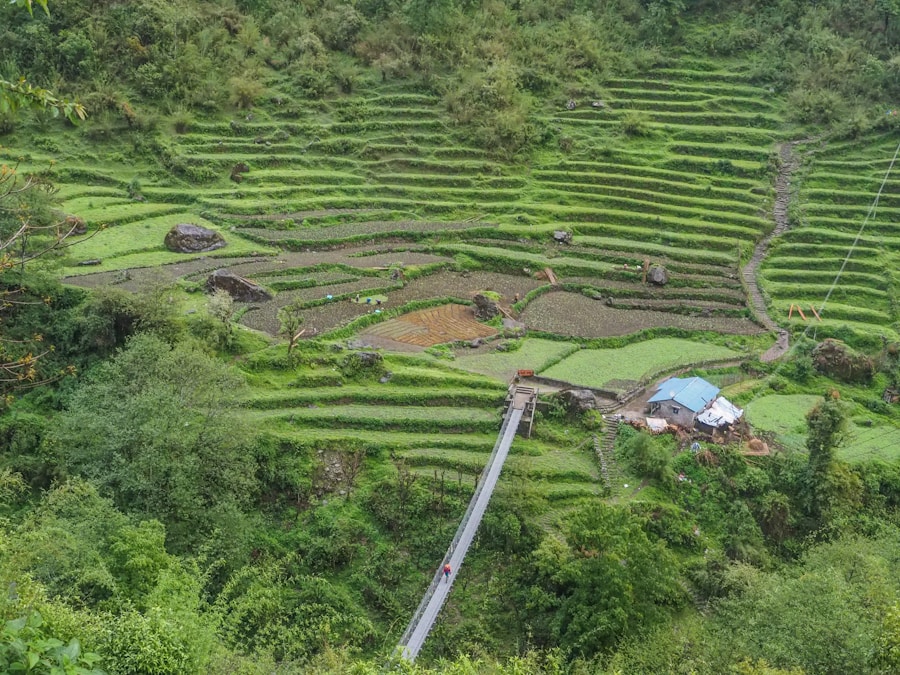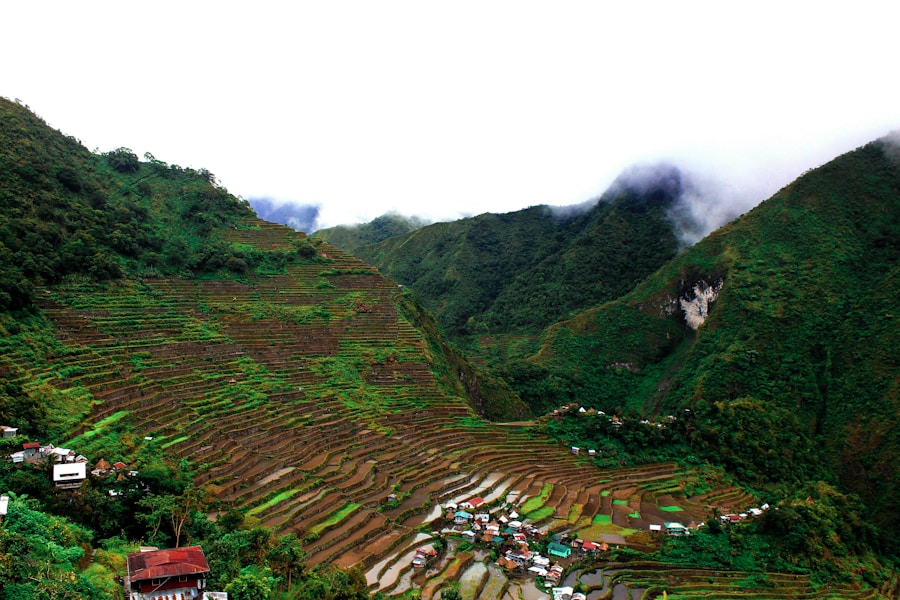Download links
How to install Banaue Rice Terraces: A UNESCO World Heritage Wonder APK?
1. Tap the downloaded Banaue Rice Terraces: A UNESCO World Heritage Wonder APK file.
2. Touch install.
3. Follow the steps on the screen.
Description
The Banaue Rice Terraces, often referred to as the “Eighth Wonder of the World,” boast a rich history that dates back over 2,000 years. These terraces were carved into the mountains of Ifugao province in the Philippines by the indigenous Ifugao people, who developed sophisticated agricultural techniques to cultivate rice in a challenging mountainous environment. The construction of these terraces is believed to have begun around 2000 B.C., although some estimates suggest that the rice cultivation practices may have started even earlier.
The terraces are not merely agricultural fields; they represent a deep connection between the Ifugao people and their land, showcasing their ingenuity and resilience in adapting to their environment. The historical significance of the Banaue Rice Terraces extends beyond their age; they are a testament to the Ifugao’s cultural heritage and traditional practices. The terraces were built using only rudimentary tools and local materials, demonstrating an impressive understanding of engineering and environmental management.
The Ifugao people utilized a system of irrigation that harnessed rainwater and natural springs, allowing them to cultivate rice in an otherwise inhospitable terrain. This intricate system of water management not only supported their agricultural needs but also fostered a communal spirit among the Ifugao, as they worked together to maintain the terraces and ensure their sustainability.
Key Takeaways
- The Banaue Rice Terraces were built over 2,000 years ago by the Ifugao people without the use of modern tools and machinery.
- The terraces are a symbol of the Ifugao’s rich cultural heritage and their sustainable farming practices, and are often referred to as the “Eighth Wonder of the World.”
- The engineering behind the terraces showcases the Ifugao’s mastery of irrigation and water management, allowing them to cultivate rice in the mountainous terrain.
- Modern threats such as deforestation, climate change, and tourism development pose significant risks to the preservation of the Banaue Rice Terraces.
- Conservation efforts include UNESCO’s recognition of the terraces as a World Heritage Site and the implementation of sustainable tourism practices to protect the cultural and environmental integrity of the area.
- Visitors can expect to witness breathtaking views of the terraces, engage in cultural exchanges with the Ifugao people, and participate in eco-friendly trekking and farming experiences.
The Cultural Significance of the Banaue Rice Terraces
The Banaue Rice Terraces are more than just an agricultural marvel; they are deeply woven into the cultural fabric of the Ifugao people. These terraces are integral to their identity, representing centuries of tradition, spirituality, and communal cooperation. The Ifugao view rice not merely as a staple food but as a sacred element that plays a vital role in their rituals and ceremonies.
The planting and harvesting seasons are marked by various cultural practices, including rituals that honor their ancestors and deities, reflecting a profound respect for nature and the cycles of life. Moreover, the terraces serve as a symbol of resilience and adaptability. The Ifugao have maintained their agricultural practices despite external pressures from modernization and globalization.
The terraces are not just fields; they are living landscapes that tell stories of generations past. Festivals such as the Imbayah Festival celebrate this rich heritage, showcasing traditional dances, music, and crafts that highlight the importance of rice cultivation in their culture. Through these celebrations, the Ifugao people pass down their knowledge and traditions to younger generations, ensuring that their cultural identity remains vibrant.
The Engineering Marvel of the Banaue Rice Terraces

The engineering behind the Banaue Rice Terraces is nothing short of extraordinary. Spanning approximately 2,000 square kilometers, these terraces are a feat of human ingenuity that exemplifies sustainable agricultural practices. The terraces were constructed using locally sourced materials such as stone, mud, and bamboo, with each layer meticulously designed to create a series of flat fields that cascade down the mountainside.
The irrigation system employed by the Ifugao is particularly noteworthy. Water is channeled from mountain springs through a network of dikes and canals that traverse the terraces.
This system ensures that each terrace receives adequate water while preventing flooding or drought conditions. The careful planning involved in this engineering marvel reflects a deep understanding of hydrology and topography, showcasing how traditional knowledge can lead to sustainable agricultural practices. The terraces are also designed to withstand seismic activity, which is crucial given the region’s geological instability.
The Threats to the Banaue Rice Terraces
| Threats | Impact |
|---|---|
| Deforestation | Loss of biodiversity, soil erosion, and landslides |
| Climate Change | Changes in temperature and rainfall patterns affecting rice production |
| Urbanization | Encroachment of infrastructure and development on terraces |
| Unsustainable farming practices | Soil degradation and reduced agricultural productivity |
Despite their historical and cultural significance, the Banaue Rice Terraces face numerous threats that jeopardize their existence. One of the most pressing issues is climate change, which has led to unpredictable weather patterns affecting rice production. Increased rainfall can cause landslides and erosion, while prolonged droughts can diminish water supply for irrigation.
These climatic changes pose significant challenges for the Ifugao farmers who rely on these terraces for their livelihoods. In addition to environmental threats, modernization and urbanization have also taken a toll on the terraces. As younger generations migrate to urban areas in search of better opportunities, traditional farming practices are being abandoned.
This shift not only threatens the maintenance of the terraces but also risks losing invaluable cultural knowledge associated with rice cultivation. Furthermore, tourism, while providing economic benefits, can lead to environmental degradation if not managed sustainably. Increased foot traffic can erode terrace walls and disrupt local ecosystems, highlighting the need for careful planning in promoting tourism while preserving this UNESCO World Heritage site.
The Conservation Efforts for the Banaue Rice Terraces
Recognizing the importance of preserving the Banaue Rice Terraces, various conservation efforts have been initiated by both local communities and international organizations. The Philippine government has implemented programs aimed at promoting sustainable agriculture and protecting these historical landscapes. Initiatives include providing training for farmers on modern yet sustainable farming techniques that can coexist with traditional practices.
These programs aim to enhance productivity while ensuring that the cultural significance of rice cultivation is maintained. Non-governmental organizations (NGOs) have also played a crucial role in conservation efforts. They work closely with local communities to raise awareness about the importance of preserving the terraces and provide resources for restoration projects.
For instance, some NGOs focus on reforestation efforts in surrounding areas to combat soil erosion and improve water quality for irrigation. Additionally, educational programs aimed at younger generations emphasize the value of traditional knowledge and encourage them to engage in terrace farming. By fostering a sense of pride in their heritage, these initiatives aim to inspire future generations to continue the legacy of the Banaue Rice Terraces.
Visiting the Banaue Rice Terraces: What to Expect

Visiting the Banaue Rice Terraces offers an immersive experience into both nature’s beauty and rich cultural heritage. Travelers can expect breathtaking views as they navigate through winding mountain roads leading to various vantage points overlooking the terraces. The sight of lush green fields cascading down steep mountainsides is nothing short of awe-inspiring, especially during planting or harvesting seasons when the terraces are alive with activity.
Upon arrival, visitors can engage with local communities through guided tours that provide insights into traditional farming practices and cultural rituals associated with rice cultivation.
Travelers may also have opportunities to participate in cultural events or festivals if their visit coincides with such occasions, allowing them to witness traditional dances, music performances, and culinary delights made from locally grown rice.
Accommodations in Banaue range from homestays with local families to more established lodges that offer stunning views of the terraces. Staying with local families provides an authentic experience where visitors can learn about daily life in Ifugao culture while enjoying home-cooked meals featuring traditional dishes made from rice. Whether hiking along terrace trails or simply soaking in the panoramic views, visiting the Banaue Rice Terraces is an unforgettable journey into a world where nature and culture harmoniously coexist.
If you are interested in learning more about sustainable agriculture practices in Southeast Asia, you may want to check out an article on the benefits of fishing for the future in Indonesia. This article discusses the importance of sustainable fishing practices for the environment and the livelihoods of local communities. You can read more about it here.
FAQs
What are the Banaue Rice Terraces?
The Banaue Rice Terraces are ancient terraces carved into the mountains of Ifugao in the Philippines. They are often referred to as the “Eighth Wonder of the World” and are a UNESCO World Heritage Site.
How were the Banaue Rice Terraces created?
The terraces were hand-carved over 2,000 years ago by the ancestors of the indigenous Ifugao people using minimal equipment. They were created to make the mountainous terrain suitable for rice cultivation.
What is the significance of the Banaue Rice Terraces?
The terraces are not only a stunning example of ancient engineering and agricultural practices, but they also hold cultural and spiritual significance for the Ifugao people. They are a symbol of their connection to the land and their ancestors.
How big are the Banaue Rice Terraces?
The terraces cover approximately 10,360 square kilometers of mountainside and are estimated to stretch about 20,000 kilometers if laid end to end.
Can visitors explore the Banaue Rice Terraces?
Yes, visitors are welcome to explore the terraces and the surrounding villages. There are hiking trails and guided tours available for those who want to experience the beauty and history of the area.





